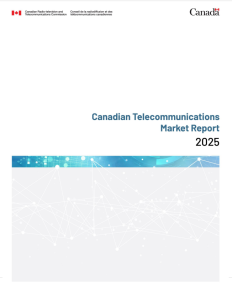 The CRTC recently released its “Canadian Telecommunications Market Report 2025”, available online or as a 73-page 1.0 MB downloadable pdf.
The CRTC recently released its “Canadian Telecommunications Market Report 2025”, available online or as a 73-page 1.0 MB downloadable pdf.
You may recall that last year, the CRTC released its Market report, labelled as “Annual highlights of the telecommunications sector 2022”, and as you will see, it can be found among the 2023 files on the CRTC website. This year’s edition is found among the 2025 files, but contains market data from 2023. Confused?
In the Executive Summary of the report, the CRTC recognized the importance of encouraging investment, but in some ways, it failed to draw a line between investment and the need for high EBITDA margins. The Commission wrote “A central challenge for the CRTC is to incentivize providers to invest, while allowing new competitors access to their networks to provide more affordable choices to Canadians.” The report observes that among comparator countries (Australia, France, Germany, Italy, Japan, and the United States), “Canada’s telecommunications service sector shows among the highest levels of capital expenditures.”
The CRTC’s Market Report could be more precise in its use of language to be more objective in its presentation of the data. For example, the Competition section of the Executive Summary leads with “Canada’s telecommunications industry has expanded to several Internet and cellphone service providers. However, a small group of large service providers maintain commanding market shares and continue to report high profit margins.”
What does this mean? How are we supposed to interpret this? Why start that sentence with “However”?
In Section 4.2 of the report, the CRTC states “Canadians benefit from competition when there is a range of service options and providers of various sizes competing in the market.” Can someone point me to an economics text that says an indicator of a markets level of competitiveness is the variety of size of service providers? Ted Woodhead suggests “It would appear that CRTC believes the ideal state would be to have a large group of small service providers with low market shares reporting low profit margins.”
Let’s look a little more closely at “a small group of large service providers maintain commanding market shares and continue to report high profit margins”. Later in the report, we see that “profit margins” are defined as EBITDA (earnings before interest, taxes, depreciation and amortization). The report leaves the reader with the impression that these EBITDA profit margins are too high, which ignores the actual financial challenges being faced by Canada’s facilities-based carriers. That is misleading. EBITDA, by definition, is a measure before taking into account interest, taxes, depreciation, and amortization. For capital-intensive businesses, EBITDA simply doesn’t reflect business profitability, especially in times of rising interest rates and high levels of investment.
The Executive Summary goes on to say “In the last two years, Internet and cellphone prices have declined nearly 10%, and roughly 25% respectively. However, Canadians have noted the opposite, with many seeing higher bills. This may be explained by some Canadians paying for more data and faster speeds.”
“May be explained”? Come on now. The phenomenon of higher bills is fully explained by customers choosing to buy higher value plans.
Let’s take a look at the data. In Figure 15, the CRTC shows some pretty significant changes in internet services prices between 2020 and 2024. In the case of 50 Mbps service, the monthly price dropped 27.4%; Gigabit per second services fell 35.6% during the same period. In Figure 16, the drop for the Internet Price Index over that same period is less dramatic, at 10.6%.
Prices for specific plans dropped more significantly than the Statistics Canada Internet Price Index. How do we account for the discrepancy?
Clearly, as the prices for various speeds fall, households are migrating to faster services, changing the norm. Figure 27 provides evidence of that migration. In 2020, only 1 in 12 households (8.3%) subscribed to gigabit internet service; just 3 years later, by 2023, more than a quarter of Canadian households (25.7%) subscribed to gig services.
On the wireless side, the same effect can be observed in Figure 43. The price for a 10 GB plan dropped nearly 60%, from $69.42 to $28.03. The 50 GB plan fell by more than two thirds, from $124.28 to $39.94. During the same period, Figure 55 shows a migration to higher capacity mobile plans.
Why would the CRTC cast shade over the fact that prices have gone down? Its phrase “Canadians have noted the opposite” should have been written as “Canadians have incorrectly noted the opposite”. Why would the CRTC be peddling public opinion – urban legends – along side of hard data? The facts show prices have gone down significantly. Why isn’t the CRTC clearly dispelling misperceptions about prices instead of contributing to the confusion?
If you can read past the biased commentary, the Canadian Telecommunications Market Report 2025 is a valuable collection of authoritative data. Just be prepared to read a report that was written with a not-so-hidden agenda.
